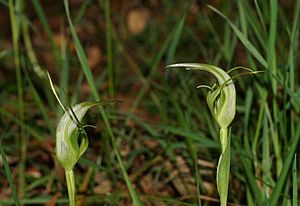Small sickle greenhood facts for kids
Quick facts for kids Small sickle greenhood |
|
|---|---|
 |
|
| Pterostylis lustra growing in western Victoria | |
| Scientific classification | |
| Genus: |
Pterostylis
|
| Species: |
lustra
|
The Pterostylis lustra, also known as the small sickle greenhood, is a special type of orchid. It grows naturally only in south-eastern Australia. When this plant flowers, it has three to five bright green leaves near the bottom of its stem. It also grows a single, unique flower that is green and white and shaped like a sickle.
Contents
What Does the Small Sickle Greenhood Look Like?
The small sickle greenhood is a plant that grows from the ground. It is a perennial plant, meaning it lives for more than two years. It's also deciduous, which means its leaves fall off during certain seasons. This plant is a herb, so it has soft stems, not woody ones like a tree. It grows from an underground tuber, which is like a small, round storage organ.
Leaves and Stem
Flowering plants usually have three to five bright green leaves. These leaves are shaped like an egg or a spear. They grow in a loose group at the bottom of the flowering stem. Each leaf is about 20 to 60 millimeters (about 1 to 2.5 inches) long. They are also about 8 to 15 millimeters (about 0.3 to 0.6 inches) wide.
The Unique Flower
A single flower grows on a tall spike, which can be 80 to 200 millimeters (about 3 to 8 inches) high. The flower itself is quite large, about 30 to 50 millimeters (about 1.2 to 2 inches) long. It is also 20 to 27 millimeters (about 0.8 to 1 inch) wide. These flowers are green and white and have a distinct sickle shape.
Flower Parts Explained
The top part of the flower, called the dorsal sepal, joins with the petals. Together, they form a hood, or "galea," over the central part of the flower called the column. The dorsal sepal is longer than the petals and ends in a sharp point. The side sepals stand upright. There is a space between them and the hood. These side sepals have thin, thread-like tips that are 20 to 30 millimeters long. There is also a wide notch where they meet. The labellum is a dark-colored part of the flower. It is blunt, about 15 to 25 millimeters long, and about 3 millimeters wide. This part sticks out above the notch. The small sickle greenhood usually flowers from late October to February.
Where Does the Small Sickle Greenhood Live?
The small sickle greenhood is quite common in the southern part of Victoria. It likes to grow in wet, swampy areas. You can often find it under a type of tea-tree called Leptospermum lanigerum. This orchid also grows in northern Tasmania and in the south-east of South Australia.
How Was This Orchid Named?
The scientific name for this plant, Pterostylis lustra, was first officially described in 2006. A botanist named David Jones gave it this name. He studied a sample of the plant found in the Wilsons Promontory National Park. The description was then published in a scientific book called Australian Orchid Research. The second part of its name, lustra, comes from a Latin word. It means "illuminate" or "light up."
Protecting the Small Sickle Greenhood
The small sickle greenhood is an important plant to protect. In Tasmania, the government has listed Pterostylis lustra as "endangered." This means it is at high risk of disappearing forever. The Tasmanian Government's Threatened Species Protection Act 1995 helps protect plants like this.

